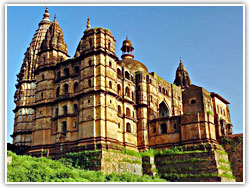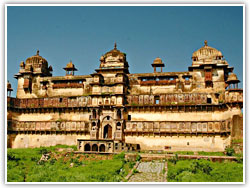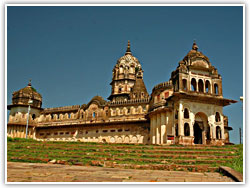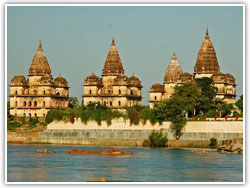|
|
Orchha, Madhya Pradesh
.............................................................................................................................................................................. |
|
Information about Orchha
Orchha is situated on a rock island on a bend in
the Betwa river and is elevated from the
surrounding wooded countryside and approached by
an arched bridge. The word ‘Orchha’ means hidden. Orchha was founded by the Bundela chief Raja Rudra
Pratap in the 16th century as his capital. It
remained the capital of the Bundela kings until
the 18th century, when it was abandoned for
Tikamgarh. Orchha is situated about 16 km. from
Jhansi and 120 kms. from Gwalior. The |
 |
|
|
fortified cluster of dwellings, temples and shrines in
Orchha bears testimony to a medieval legacy in stone.
The best time to visit Orchha is from October to March.
History of Orchha
Garkhundar, once capital of the Bundela Rajas, fell to
the Tughluqs, as that dynasty was weakening. The
Bundelas later expanded their control, moving their base
in the early 16th century to Orchha. Raja Rudra Pratap
threw a wall around the existing settlement and built
the first palace, the Ramji Mandir and a bridge to it.
Before his death, he started the construction of the Raj
Mahal. This work was finally completed in 1591 by his
successors, Bharti Chand and Madhukar Shah. Though
Madhukar Shah was defeated in battle by Akbar, he
nevertheless won the Mughal emperor’s friendship. Later,
the Bir Singh Deo, while opposing Akbar, aligned himself
with Jahangir and is believed to have killed Abu Fazl,
one of Akbar’s closest friends and supporters, at
Jahangir’s instigation. He was rewarded when Jahangir
succeeded his father and thus ensured the ongoing
prosperity of Orchha. The Jahangir Mahal was built to
commemorate the emperor’s visit to Orchha. However, Bir
Singh’s first son, Jhujan, ran foul of Shah Jahan and,
ignoring orders, killed the neighbouring chief of
Chauragarh. Jhujan was killed in the jungle by Gonds.
Orchha was then pillaged. In 1783, the Bundela capital
was moved to Tikamgarh, leaving Orchha to the jade green
dhak forests, the Betwa river and its guardian eagles.
Orchha is now a famous tourist destination, on the way
from Gwalior to Khajuraho.
Tourist Attractions in Orchha
There are three palaces in Orchha, each built by
succeeding Maharajas in a similar style and combined to
form a complex. The three main palaces are the Raj Mahal,
Jahangir Mahal and Rai Praveen Mahal. The Ramji Mandir,
Ram Raja Temple, Laxminarayan Temple and the Royal
Chattris are the other tourist attractions in Orchha.
Ramji Mandir
The Ramji Mandir is the prototype of Bundela Rajput
architecture and has a central rectangular courtyard and
apartments rising in receding plains. Much of the
original blue tile decoration remains on the upper outer
walls. The Raj Mahal comprises of a solid block crowned
by pavilions. This palace was built by the Madhukar
Shah. Despite its crumbling look, the wall paintings,
portraying the Hindu religious mythology are strong and
vivid. |
|
|
|
Jahangir Mahal
The Jahangir Mahal is the most famous palace and
was built by the Bundela kings in the 17th century
and one of the best examples of medieval
fortification in India. The Jahangir Mahal is the
most impressive palace and a mixture of Hindu
(brackets decorated with elephants, chattris) and
Muslim styles (a formal garden, pavilions and jail
lattice work). The Jahangiri Mahal is a wonderful
example of Rajput Bundela architecture, with its
lapis lazuli tiles, jail screens, and billowing
cupolas.
|
 |
|
|
Jahangir Mahal, combines the ruler Bir Singh Deo’s eye
for detail with sweeping views from its turrets. The
palace is named after Jahangir, who spent a night there.
There are 132 rooms off and above the central courtyard
and an almost equal number of subterranean rooms.
Hanging balconies with wide eaves provides the shade
from the sun and numerous windows give this huge palace
a delicate and airy feel. The palace also contains a
small museum. In the area surrounding the palace are
about 100 temples. These temples are located near the
confluence of the Betwa and Jamni river.
Ram Raja Temple
The Ram Raja Temple is situated near the Raj Mahal. This
temple is unusual since it is the only one temple in the
country where Lord Rama is worshipped as a king. Due to
a dream visit by the god Rama, the Madhukar Shah brought
a statue of the Lord from Ayodhya to his capital. The
image was placed in the palace before its installation
in the temple. When the time came to shift it, it proved
impossible to move and Madhukar Shah remembered the
deity’s edict that the image must remain in the place
where it was first installed.
Rai Parveen Mahal
Poetess and musician, Rai Parveen was the beautiful
paramour of Raja Indramani (1672- 76) and was sent to
Delhi on the orders of the Emperor Akbar, who was
captivated by her. She so impressed the Great Mughal
with the purity of her love for Indramani that he sent
her back to Orchha. The palace built for her is a low,
two-storeyed brick structure designed to match the
height of the trees in the surrounding, beautifully
landscaped gardens of Anand Mahal, with its octagonal
flower beds and elaborate water supply system.
Skillfully carved niches allow light into the Mahal
which has a main hall and smaller chambers. |
|
|
|
Laxminarayan Temple
The Laxminarayan Temple is located near the Ram
Raja temple. This temple is dedicated to the
goddess Laxmi, the Goddess of Wealth. The 17th
century brick structure combines the architecture
of a temple and a fort. There are attractive wall
paintings of the developed phase of the
Bundelkhand school of art. There is a fine view
from the back of the temple, across the plain to
the chattris and palace.
Chaturbhuj Temple |
 |
|
|
Built upon a massive stone platform
and reached by a steep flight of steps, the temple was
specially constructed to enshrine the image of Rama that
remained in the Ram Raja Temple. Lotus emblems and other
symbols of religious significance provide the delicate
exterior ornamentation. Within, the sanctum is chastely
plain with high, vaulted walls emphasizing its deep
sanctity.
Phool Bagh
Laid out as a formal garden, this complex testifies to
the refined aesthetic qualities of the Bundelas. A
central row of fountains culminates in an eight pillared
palace-pavilion. A subterranean structure below was the
cool summer retreat of the Orchha kings. An ingenious
system of water ventilation connects the underground
palace with Chandan Katora, a bowl-like structure from
whose fountains droplets of water filtered through to
the roof, simulating rainfall.
Raj Mahal
Situated to the right of the quadrangle, this palace was
built in the 17th century by Madhukar Shah, the deeply
religious predecessor of Bir Singh Ju Deo. The plain
exteriors, crowned by chhatris, give way to interiors
with exquisite murals, boldly colourful on a variety of
religious themes. |
|
|
|
The Royal Chattris
There are 14 cenotaphs or the royal chattris of
the former rulers grouped by the Kanchana Ghat on
the banks of the river Betwa. These cenotaphs are
overgrown and neglected and fine views can be
obtained from them. These chhatris can be best
viewed from the bridge connecting the massive
midstream island.
Sunder Mahal
This small
palace, almost in ruins today is
|
 |
|
|
still a
place of pilgrimage for Muslims. Dhurjban, son of
Jhujhar, embraced Islam when he wed a Muslim girl at
Delhi. He spent the latter part of his life in prayer
and meditation and came to be revered as a saint.
Shahid Smarak
Commemorates the great freedom fighter Chandrashekhar
Azad who lived and worked in hiding in Orchha during
1926 and 1927.
Other places worth seeing are the shrines of Siddh Baba
Ka Sthan, Jugal Kishore, Janki Mandir and the Hanuman
Mandir at Ochharedwara.
How to reach Orchha
By Air:
The nearest airport is located in Gwalior, about 120 kms.
away from Orchha.
By Rail:
The nearest railway station is located at Jhansi, about
19 km away from Orchha.
By Road:
Orchha lies on the Jhansi–Khajuraho road, about 16 km
from the Junction of NH 25 and 26. It is connected by
road to Agra, Jhansi, Gwalior and Khajuraho. |
|